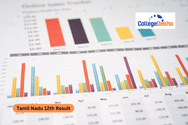

Never Miss an Exam Update
Tamil Nadu Class 12 Accountancy Syllabus 2025: The Directorate of Government Examinations, Tamil Nadu will publish the detailed TN HSC syllabus Accountancy for the academic year 2025 on its official website at dge.tn.gov.in. Accountancy is one of the important subjects for Commerce stream students apart from 3 other main subjects and 2 compulsory Language papers. Students can find the Tamil Nadu Class 12 Accountancy Syllabus 2025 in both the mediums, Tamil, and English in PDF format. The syllabus includes a total of 9 units. The highest weightage unit is unit 9, Accounts of joint stock companies which will itself carry 35 marks. The Tamil Nadu 12th Accountancy Exam 2025 will be conducted for a total marks of 100. Students will be provided with a maximum time of 2 hours, and 30 minutes for the paper. TN Board announced the TN HSC exam time table 2025 on its official website in November 2025. The Tamil Nadu HSC board exam 2025 will be in March 2025. To know more about the updated Tamil Nadu Class 12 Accountancy Syllabus 2025, complete reading the article.
Tamil Nadu Class 12 Accountancy Syllabus 2025: Download PDF
Click on the link provided below to download the Tamil Nadu Class 12 Accountancy Syllabus 2025 PDF:
How to Download Tamil Nadu Class 12 Accountancy Syllabus 2025?
Students can follow the given below instructions to download the Tamil Nadu Class 12 Accountancy Syllabus 2025 from the official website of the state board:
- Step 1: Students will first need to browse the official website of the Tamil Nadu board.
- Step 2: On the homepage, find and click on the option called "Syllabus 2025".
- Step 3: A new window will be displayed where you will find a list of different subject syllabus PDFs.
- Step 4: Click on the class 12th Accountancy subject syllabus to download.
- Step 5: Download the Tamil Nadu Class 12 Accountancy syllabus PDF and save it for future reference.
Tamil Nadu Class 12 Accountancy Syllabus 2025
Units | Content | No. of Periods |
|---|---|---|
1. Depreciation | 1.1. Introduction 1.1.1 Meaning 1.1.2. Definition 1.2. Need 1.3. Causes 1.4.Basic terms 1.4.1.Fixed asset 1.4.2. Life of an Asset 1.4.3. Residual value 1.4.4.Obsolescence 1.4.5. Effluxion of time 1.4.6. Maintenance 1.4.7. Replacement 1.5. Methods 1.5.1. Straight Line Method Illustration 1.5.2. Written Down value Method 1.5.3. Sinking fund method 1.5.4. Annuity method 1.5.5. Insurance policy method 1.5.6. Revaluation method 1.6. Calculation of amount of depreciation – illustration 1.6.1 Calculation of Rate of depreciation – illustration 1.7. Calculation of Profit or Loss on sale of asset (restricted to purchase and sale of one asset) 1.8. Preparation of Asset Account and Depreciation Account under Straight Line & Written Down method | 14 |
2. Final accounts adjustments | 2.1. Introduction 2.2. Common adjustments 2.2.1. Closing stock 2.2.2. Outstanding expenses 2.2.3. Prepaid expenses 2.2.4. Accrued incomes 2.2.5. Incomes received in advance 2.2.6. Interest on capital 2.2.7.Interest on drawings 2.2.8.Interest on loans 2.2.9.Depreciation 2.2.10. Bad debts 2.2.11.Provision for bad & doubtful debts 2.2.12. Provision for discount on debtors 2.2.13. Provision for discount on creditors 2.3. Preparation of final accounts with a maximum of 20 items and 6 adjustments including closing stock. Illustration including adjusting entries, transfer entries and problems with 6 adjustments only | 24 |
3. Interpretation of financial statements | 3.1 Financial statement analysis 3.1.1. Meaning 3.1.2. Significance 3.1.3.Purpose 3.1.4. Limitations 3.2. Ratio analysis 3.2.1. Meaning 3.2.2. Role 3.3. Classification of ratios 3.3.1. Liquidity ratio- meaning & calculation 3.3.1.1. Current ratio 3.3.1.2. Liquidity ratio 3.3.1.3. Quick ratio 3.3.1.4. CalculationIllustration 3.3.2. Solvency ratios 3.3.2.1. Debtequity ratio 3.3.2.2. Debttotal funds ratio 3.3.3. Profitability ratios 3.3.3.1. Gross profit ratio 3.3.3.2. Operating ratio 3.3.3.3. Net profit ratio 3.3.3.4. CalculationIllustration 3.3.4. Activity ratios 3.3.4.1. Capital turnover ratio 3.3.4.2.Fixed assets turnover ratio 3.3.4.3. Stock turnover ratio 3.3.4.4. Debtors turnover ratio 3.4. Calculation of liquidity ratios (3) and profitability ratios (3) with necessary items only | 28 |
4. Cash Budget | 4.1. Introduction 4.2. Meaning 4.3. Utility 4.4. Preparation of cash budget as per receipts and payments method (simple problems) – Illustration Maximum of 3 months restricted to five items only | 7 |
5. Accounts from incomplete records | 5.1. Introduction 5.1.1. Meaning 5.1.2. Definition 5.1.3. Features 5.1.4. Limitations 5.2. Ascertainment of profit or loss 5.2.1. Statement of Affairs method 5.2.1. Preparation of statement of profit or loss illustration 5.2.1.2. Preparation of statement of affairs – illustration 5.2.2. Conversion method 5.2.2.1. Preparation of trading, profit and loss account and balance sheet with simple problems by opening important ledger accounts – debtors, creditors, cashillustration 5.3. Distinction between accounts from incomplete records and double entry | 21 |
6. Partnership basic concepts | 6.1. Introduction 6.1.1. Meaning 6.1.2 Definition 6.1.3. Features 6.2. Capital 6.2.1. Fixed capital 6.2.2. Fluctuating capital. 6.2.3. Preparation of capital accounts –Illustration 6.3. Distribution of profit 6.3.1. Interest on capital 6.3.2. Interest on drawings 6.3.3. Salary, commission to a partner 6.3.4. Preparation of profit and loss appropriation account 6.4. Goodwill 6.4.1. Meaning and nature 6.4.2. Factors 6.4.3. Methods of valuing the Goodwillaverage period, super profit method | 14 |
7. Partnership Admission | 7.1. Introduction 7.1.1. Adjustments 7.2. New profit sharing ratio illustration 7.2.1 calculation of new profit ratio and sacrificing ratio illustration 7.3.Revaluation of assets and liabilities 7.3.1. Increase in the value assets 7.3.2. Decrease in the value of assets 7.3.3. Increase in the value of liabilities 7.3.4. Decrease the value of liabilities 7.3.5. Unrecorded assets now recorded 7.3.6. Unrecorded liabilities now recorded 7.3.7.Creation of a liability 7.3.8. Profit or loss on revaluation illustration 7.4. Transfer accumulated profit or lossillustration 7.5. Transfer of accumulated reserve – illustration 7.6. Treatment of Goodwill (Revaluation method only)- illustration 7.7. Capital brought in by a new partnerillustration 7.8. Preparation of revaluation A/c, capital accounts and balance sheet after admission of a partner illustration | 28 |
8. Partnership Retirement | 8.1.Introduction 8.1.1. Adjustments 8.2. New profit ratio 8.2.1. Calculation of new profit ratio – Illustration 8.2.2. Calculation of gaining ratio illustration 8.3. Revaluation of Assets and liabilities – illustration 8.4. Transfer of accumulated profit or lossillustration 8.5. Adjustment of Goodwill illustration 8.6. Transfer of reserves illustration 8.7. Transfer of the amount due to the outgoing Partnerillustration 8.8. Preparation of revaluation account, capital accounts and balance sheet after retirement of a partner illustration | 19 |
9. Accounts of joint stock companies | 9.1.Introduction 9.1.1. Definition 9.1.2. Characteristics 9.2. Sources of finance 9.3. Share capital 9.3.1. Meaning of shares 9.3.2. Kinds of shares 9.3.3. Types of share capital a) Authorized b) Issued c) Subscribed d) Called-up e) Uncalled f) Paid-up 9.4. Issue of shares 9.4.1. Application 9.4.2. Allotment 9.4.3. Calls 9.5. Allotment of shares including over subscription 9.5.1.Issue of shares at per illustration 9.5.2. Issue of shares at a premiumillustration 9.5.3.Issue of shares at a discountillustration 9.6. Calls in advance illustration 9.7.Calls in arrears illustration 9.8. Forfeiture of shares meaning and accounting treatment 1) Shares issued at par, 2) At a premium and 3) At a discount (simple problems)- illustration 9.9. Re-issue of forfeited shares 9.9.1. Meaning 9.9.2. Accounting treatment for reissue of forfeited shares issued 1) At par 2) At a premium 3) At a discount (simple problems)- illustration 9.10. Passing of necessary journal entries and preparation of ledger accounts and balance sheet giving effect to the above items illustration | 35 |
Tamil Nadu Class 12 Accountancy Question Paper Design
Tamil Nadu Class 12 Accountancy question paper is divided into 4 parts. The students get 3 hours to solve 47 questions worth 90 marks. There will be choices available in the questions. Students can go through the instructions and attempt the questions.
Parts | Marks |
|---|---|
Part I | 20 marks |
Part II | 14 marks |
Part III | 21 marks |
Part IV | 35 marks |
Total Marks | 90 marks |
Preparation Tips for Tamil Nadu Class 12 Accountancy
The students can check and follow the important tips given below to prepare for the Tamil Nadu Class 12 Accountancy exam. These tips can help students to perform better and score good marks.
Complete Syllabus in Advance - The students can regularly go through the syllabus and cover up the syllabus beforehand. They can devote the required time to each of the chapters. While preparing, students should also solve numerical problems.
Solve Questions Regularly - After completing the syllabus, students can solve the questions. They can download the previous year question papers and start practicing the questions. This will give them an idea about the pattern of questions in the exam.
Revise the Syllabus - While preparing for board exams, students should revise the Accountancy syllabus at least once after completing the syllabus. Through revision, students will be able to focus more on the chapters that carry high marks.
Focus on Speed and Accuracy -
The students should try to attempt all questions accurately within the time. The students can plan a strategy and devote the required time for each of the sections.
Also Read -
Tamil Nadu 12th Grading System 2025
The Tamil Nadu State Board organizes the Tamil Nadu 12th exam 2025 on the complete syllabus prescribed by the board. Any changes in the syllabus will be updated here on this page. Students are advised to complete the entire TN Class 12th syllabus at least 2 months before the exam.
FAQs
Students can go through the Tamil Nadu Class 12 Accountancy syllabus and check the marks allotted to each of the chapters. According to the marks provided to chapters, they can prepare the chapters.
The students are suggested to regularly go through the Tamil Nadu Class 12 Accountancy syllabus. After completing the syllabus, students can solve the questions for different chapters. Through regular practice, students will find it easy to solve the questions.
To score high marks in the Tamil Nadu Class 12 Accountancy, students should complete the syllabus beforehand and start practicing the questions. After knowing their strengths and weaknesses, they can focus on the required topics.
The students should divide the Tamil Nadu Class 12 Accountancy syllabus into smaller units and start preparing from day one. The regular study will make it possible for students to understand the syllabus and perform well in exams.
Was this article helpful?
























